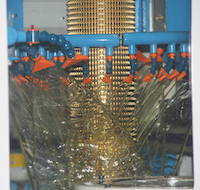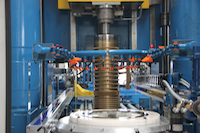Broaching is a machining process that uses a toothed tool, called a broach, to remove material. Linear broaching, which is the more common process, the broach is run linearly against a surface of the workpiece to effect the cut. Linear broaches are used in a broaching machine, which is also sometimes shortened to broach. In rotary broaching, the broach is rotated and pressed into the workpiece to cut an axis symmetric shape. Broaching is used when precision machining is required,and even though broaches can be expensive, broaching is usually favored over other processes when used for high-quantity production runs.
Broaches are shaped similar to a saw, except the teeth height increases over the length of the tool. Moreover, the broach contains three distinct sections: one for roughing, another for semi-finishing, and the final one for finishing. The profile of the machined surface is always the inverse of the profile of the broach. The rise per tooth (RPT), also known as the step or feed per tooth, determines the amount of material removed and the size of the chip. Because all of the features are built into the broach no complex motion or skilled labor is required to use it. The cut of a broach is effectively analogous to multiple passes of a shaper.
The internal broaching process begins by clamping the workpiece into a special holding fixture, called a workholder, which mounts in the broaching machine. The broaching machine elevator, which is the part of the machine that moves the broach above the workholder, then lowers the broach through the workpiece. Once through, the broaching machine's puller, essentially a hook, grabs the pilot of the broach. The elevator then releases the top of the pilot and the puller pulls the broach through the workpiece completely. The workpiece is then removed from the machine and the broach is raised back up to reengage with the elevator.
Because each broach is specialized to cut just one shape either the broach must be specially designed for the geometry of the workpiece or the workpiece must be designed around a standard broach geometry.
Broaching can be used for a high variety of materials including steel (42CrMo, 20CrMn, 31CrMoV9, 40Cr, 50Mn …) and casting.
Why choose broaching? “Just” for three principal reasons:





